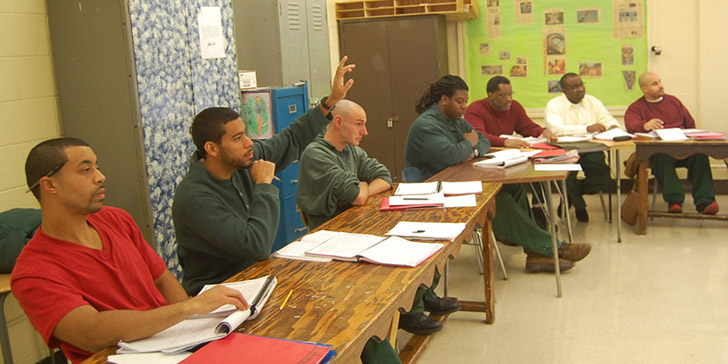Education as Social Transformation
Introduction
I am a professor in the religious studies department at Manhattan College. Each semester I teach a course entitled Criminal Justice Ethics at the New York City jail complex on Rikers Island. Half of the students are from our main campus; the other half includes either men or women from one of the jails on the island. The course has a deliberately secular title, but the intent is to trace significant ethical questions raised in the apprehension, prosecution, and detention of individuals to their roots in the Judeo-Christian tradition. The parallel goal is to reframe the entire structure and practice of criminal justice in terms of an inclusive, compassionate, and restorative vision of human weakness, human potential, and human fulfillment.
Challenges
Teaching at the jail presents a number of challenges beside the normal and significant pedagogical concerns of creating a harmonious classroom environment, stimulating creative and critical appreciation of the texts, and encouraging, accompanying, and providing tutorial help for the incarcerated students who, for the most part, are taking their first college class.
The first of these challenges is Rikers Island itself. It has been the focus of almost constant local attention in recent years due to its appalling rates of suicide, homicide, violence, and the well-documented and life-threatening indifference of many of the officers and staff to the needs of the sick, the mentally ill, and the vulnerable members of the confined population. There have been repeated calls from community and political leaders to close the facility entirely. The effect for those of us who run programs there is the moral and communicative fault line that has grown—and become increasingly more unstable—between many of the uniformed personnel and their civilian counterparts both at the jail and in the wider community. This has served to saddle service providers with an unprecedented and often deleterious lack of attention, and even demonstrative inattention, to the processing, movement, and access to services that enable the class to function. For example, in our class in the fall of 2015 in a jail serving eighteen- to twenty-four-year-old males, a significant percentage of the students were late each week despite the fact that the officers in each housing unit were notified three hours prior to the beginning of the class. I also received an angry complaint from one of the captains describing his “perception,” and that of many of the prison personnel, was that our young women were at the jail “slumming” and showing themselves off rather then engaging in a serious and honorable educational pursuit. All of this despite the fact that the students are supervised at all times, and the young women in question were deeply committed to the mission of our program and the men with whom they worked.
The second significant challenge is the often radical instability of the men and women we serve. Jails house two classes of persons: detainees (those awaiting trial) and those who are serving their sentences for misdemeanors or low-grade felonies. If the class consists of detainees, we stand to lose them at some point during the semester if they are either released or, more typically, found guilty and sent to an upstate penitentiary. We must also be attentive to the often severe emotional, spiritual, and psychological trauma that they undergo as they await the adjudication of their cases. It is difficult to balance the need to make inattentive or underprepared students accountable with the compassion that naturally arises upon seeing the painful and fearful look in their eyes as they await or are in the midst of a trial, the result of which could quite literally prove fatal to them.
The third challenge in teaching at the jail is at once the most pressing and, potentially, the most life-enhancing. The typical man or woman who takes the class is black or brown, poor, already with a criminal record, and has a home address that is either a shelter or in an unstable living situation in some of this nation’s most violent and economically depressed neighborhoods. We attempt to rectify this daunting set of circumstances by providing each of the confined students who complete the class the opportunity to come to our school and take classes free of charge. This opportunity finds its way into the curriculum and our relationships with the students as the course must include material on, and provide a forum to discuss, the reentry process and the significant barriers that exist to the successful integration of former offenders into the mainstream of society.
Course Goals and Questions
While the obstacles are significant, the goals we seek to meet far exceed the frustrations involved in our efforts. In terms of practical theology, the course is designed to draw as much as possible upon what is termed the “hermeneutical privilege of the poor.” All class sessions revolve around the conversations we foster between our typically privileged students from the main campus and the incarcerated men or women who, as poor members of racial minorities, have by and large been consciously excised from the main lines of social mobility. Each semester, the texts come alive as our jailed students share a narrative that unmasks the facile justifications that overwhelmingly punish the poor for their character foibles and just as overwhelmingly casts a blind eye to the similar (or worse) character flaws of the well-to-do. These conversations also provide the basis for peer mentoring, not only as the incarcerated help their visiting classmates to see the faces behind penal demographics, but also as our outside students share the skills they have learned in reading comprehension, note taking, and paper preparation with their classmates from the jail. The conversations also form bonds of deep personal care and, hopefully, commitment. For, as mentioned, our proximate aim is to integrate the men and women from the jail into our campus life after they are released with the hope that each will obtain an undergraduate degree. Our long term goal is for all of our students to be active in reforming the criminal justice system in terms of the theological commitments to accountability, reconciliation, and restoration.
The course content is constructed around three questions: Why do we punish? Who do we punish? How do we punish? For each question, an overview is created wherein contemporary answers to the questions are presented alongside answers provided either from the history of the church or from significant theological figures. For example, in addressing the question of the justification for punishment, students read Immanuel Kant‘s influential argument that no circumstantial factors lessen the gravity of crime and therefore that punishment must exact a toll from the offender that is commensurate with the harm caused. Jeremy Bentham’s writings are discussed to highlight the logic of deterrence—that punishment should act as a warning both to the offender and to society that there are stern consequences awaiting those tempted to disobey the law. These approaches are then weighed against the position held by Saint Thomas Aquinas. He maintained that each person is called to live a virtuous life, and therefore, punishment cannot be an end in itself or principally a means to summon obedience; rather, the formal goal of incarceration should be “medicinal”: to heal the wounds that have led to alienation from oneself, from the community, and from God.
Each question stimulates informed discussion and, not uncommonly, passionate debates as the often taken-for-granted legitimacy of law, judgment, confinement, and punishment are examined and critiqued with perspectives drawn largely from the Judeo-Christian tradition. Students are provoked and even inspired when we learn about how criminal justice was practiced a millennium ago and how its moral framework was dominated by Christian theological concerns. They are first reminded (or made aware) of the radical teaching of Jesus regarding the legitimacy of judging anyone. Then they are both surprised and challenged to learn that most people at that time believed his teachings, the result being that it became virtually impossible to find witnesses who would testify, even against an individual known to have committed a crime. Finally, they are generally astonished to learn that the birth of the jury trial was not a victory of democratic jurisprudence but an attempt by the nobility and magistrates to force common people to hand down punishment or death rather than have that onus—and the need to answer to God for failing to heed the teaching of the Gospel—fall upon themselves.
Conclusion
The class at the jail has affected the lives of those who have taken it in remarkable and life-changing ways. Not only are there a number of formerly confined men and women now pursuing a baccalaureate degree at Manhattan College, but many of the students from our main campus have adjusted their career choices and dedicated themselves to work for social justice and for the reform of our criminal justice system.
From my own perspective, I have been led to see that civic engagement is not an exotic addendum to the “real” activity of intellectual training. It is now apparent that the only education that sticks is that which proceeds from experience. It is in providing such experiences, especially ones that address human suffering and the institutions that legitimate that suffering, as well as the opportunity to reflect upon that experience with those directly affected by it, that we not only become true educators but also use education as the vehicle to personal and social transformation.
 Andrew Skotnicki teaches Christian ethics at Manhattan College in New York City. He is the author of Religion and the Development of the American Penal System (University Press of America, 2000), Criminal Justice and the Catholic Church (Rowman & Littlefield, 2008), and The Last Judgment: Christian Ethics in a Legal Culture (Routledge, 2012). He is founder and director the E3MC program (Engaging, Educating, and Empowering Means Change), an educational partnership between Manhattan College and the New York City Department of Corrections.
Andrew Skotnicki teaches Christian ethics at Manhattan College in New York City. He is the author of Religion and the Development of the American Penal System (University Press of America, 2000), Criminal Justice and the Catholic Church (Rowman & Littlefield, 2008), and The Last Judgment: Christian Ethics in a Legal Culture (Routledge, 2012). He is founder and director the E3MC program (Engaging, Educating, and Empowering Means Change), an educational partnership between Manhattan College and the New York City Department of Corrections.
Photo: A student raises his hand in a English seminar facilitated by Cornell University at the Auburn Correctional Facility. Credit: Cornell Prison Education Program.

